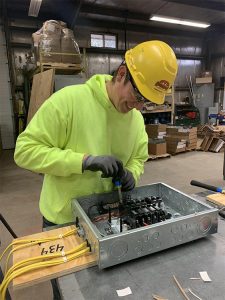Challenges for employers include the ability to provide good mentors who are patient about sharing their talents and remembering that youth apprentices are younger workers who have limits. Contractors also must be conscious about tool restrictions. Suburban Electrical Contractors/Engineers and many other ABC of Wisconsin members have worked through the logistics.
There are also challenges for students. With some job sites a significant distance from town, many YA students will get the bulk of their work hours in the summer. In addition to transportation, students have to work out a schedule for a real-work environment and remember to be students first. Regardless of the challenges, students all seem to have one common denominator: a passion to learn on the job.
“Going through a youth apprenticeship was very beneficial for me,” said Owen Aerts, who works for Suburban Electrical Contractors/Engineers and was one of the first construction youth apprentices in the state.
“It allowed me to learn new things and see firsthand what a career in the electrical field looks like,” said Aerts, who is now in his third year of the adult electrical apprenticeship program.
As of this upcoming school year – thanks to the ABC-backed legislation to allow adult registered apprenticeship for seniors in high school – the pathway between youth apprenticeship and adult registered apprenticeship in high school has been connected. The measure allows qualified high school seniors to begin adult apprenticeship programs early, therefore bridging the two programs for the first time.
“When Suburban informed us they were planning on putting a youth apprentice into the registered adult apprenticeship program, we were very excited,” said Leigh Emrick, ABC of Wisconsin Apprenticeship director. “This means the two paths are being connected into a larger pathway.”
Since that time, the company has committed to putting three of its youth apprentices into the registered adult apprenticeship program. One of these individuals is Dakota Schuh, a high school junior whose experience as a youth apprentice has convinced him that apprenticeship is a better option than college.
“I learn better when I am doing a task,” Schuh said. “In the apprenticeship, I use my hands and see how things go together. It’s not just a book that you have to read. You have to solve real-life problems.”
He is also pleased that he gets paid to go to school.
“For me, this will create a drive to do good in school,” said Schuh, who will acquire his journeyman’s card with little to no debt. “I can start full time right after high school and start making good money. This is the key factor that drove me to go into the trades.”
Establishing a program like this doesn’t come without some effort by contractors and some accommodations by high schools.
“Our challenge was quickly making this as seamless as possible,” said Emrick. She is referring to the discussions that contrac-tors need to have with guidance counselors and others and the high schools to make this happen.
Adult apprentices in high school need to tweak their class schedules to attend paid-related apprenticeship instruction every other week. First-year apprentice classroom hours are at a set time, so students need to work around them, to not miss class. They also need to work around their schedules to acquire enough on-the-job training. It should be noted that youth apprenticeship work hours are transferable to adult apprenticeship.
“We’re doing due diligence on our end, to make sure that it’s successful for those individuals who are in high school and want to get into youth apprenticeship and/or reg-istered adult apprenticeship,” Emrick said. “It’s certainly an investment on the part of the contractor who really makes it happen, but it’s worthwhile.”
Interestingly, high schools who lose youth apprentices to adult apprenticeship lose grant funding, so there may be some understandable reluctance by school districts.
“Generally speaking, though, high schools have been very accommodating for these programs because they want to see their students succeed in a career path. Now, even before graduation, they’re gainfully employed and at their high school graduation they will be second-year apprentices,” said Emrick. “That’s really cool.”











